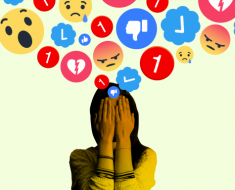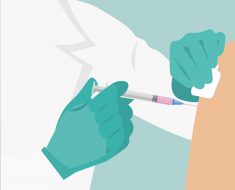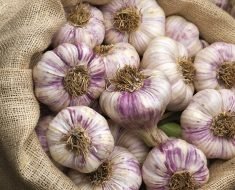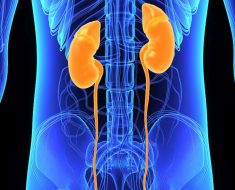Cancer-causing contaminants may be in your drinking water, according to a new study published in the journal Heliyon.
Scientists at the Environmental Working Group (EWG) analyzed pollutants in tap water from 2010 to 2017. They found 22 carcinogenic contaminants — including arsenic, disinfection byproducts, and radioactive contaminants, such as uranium and radium — in drinking water nationwide, which researchers estimate could, over the course of an average lifetime (about 70 years), lead to 100,000 cases of cancer.
In the study, EWG scientists calculated the cumulative health effects of these carcinogens in more than 48,000 community water systems in the U.S. (not including the 13.5 million Americans who rely on private wells for drinking water).
8 PHOTOSThese eight foods and drinks can contribute to cancerSee GalleryThese eight foods and drinks can contribute to cancer
1. Processed meat
The World Health Organization places processed meat in the same category as tobacco smoking and asbestos when it comes to carcinogenicity. Although the three groups are not considered equally dangerous, processed meat has been proven to cause colorectal cancer. Studies show that "every 50 gram portion of processed meat eaten daily increases the risk of colorectal cancer by about 18 [percent]," the U.N. agency notes.
Research has also found a connection between processed meat and stomach cancer, but the evidence is not conclusive.

2. Salt-cured meat or fish
Salt-cured foods tend to have high levels of nitrates and nitrites, both of which react with amines and amides to form compounds that can lead to cancer, according to the National Cancer Institute.
Moreover, research shows that "the more people eat of these foods the greater their chance of developing stomach cancer," Dr. Stephanie Fay wrote for World Cancer Research Fund International.

3. Pickled foods
Much like salt-cured food, pickled foods contain a strong amount of nitrate and nitrate. A 2012 survey published by the American Association for Cancer Research revealed a direct correlation between the consumption of pickled vegetables and gastric cancer. Those of East Asian descent are particularly vulnerable to the disease since their diet heavily consists of pickled foods, the study said.

4. Grilled food
Grilling food over an open flame creates heterocyclic amines and polycyclic aromatic hydrocarbons, two types of chemicals that can cause changes in the DNA, thereby increasing the risk of cancer, the National Cancer Institute points out. Researchers determined that high consumption of well-done, fried or barbecued meats led to increased risks of colorectal, pancreatic and prostate cancer.

5. Microwave popcorn
Microwave popcorn contains a toxic compound called diacetyl, which can cause scarring of the tiny air sacs in the lungs and has been linked to lung cancer, Eitan Yefenof of the Hebrew University of Jerusalem told Reader’s Digest.
The health threat actually comes from the popcorn bags, which contain chemicals that are suspected to cause cancer, according to Healthline. Those chemicals can also be found in pizza boxes, sandwich wrappers and Teflon pans.

6. Alcohol
Heavy consumption of alcohol increases the risk of developing cancers of the oral cavity, pharynx, larynx, esophagus, liver, breast, colon and rectum, says the National Cancer Institute. The U.S. government’s Dietary Guidelines for Americans 2015-2020 defines "heavy alcohol drinking" as "having 4 or more drinks on any day or 8 or more drinks per week for women and 5 or more drinks for men in one sitting (typically in about 2 hours)." Those who drink should do so in moderation (one drink per day for women and up to two drinks per day for men).

7. Bagels
As mouth-watering as bagels are, they’re also a health risk, particularly for non-Hispanic whites. Bagels have a high glycemic index, which means that they can significantly raise blood sugar levels. Elevated blood sugar levels trigger the secretion of insulin, which, in turn, can influence the risk of lung cancer, according to a 2016 study published by the American Association for Cancer Research.

8. Soda
Drinking carbonated beverages heavily can exacerbate the symptoms associated with cancer, such as gas, bloating, heartburn or reflux, according to Stacy Kennedy, a senior clinical nutritionist at Dana-Farber Cancer Institute.
In addition, many soft drinks contain high fructose corn syrup, which can contribute to weight gain and obesity. Obesity itself has been linked to 13 different types of cancer, including breast, esophageal and endometrial cancers.
See Gallery
“The results of this analysis show that, over a lifetime of exposure to these contaminants in drinking water, we would expect that 100,000 cancer cases in the United States would be due to these drinking water contaminants,” Sydney Evans, lead author of the study and a science analyst at EWG, tells Yahoo Lifestyle. “Contaminants present in drinking water all across the United States — at concentrations that are perfectly legal and get a passing grade from federal government — can still increase the risk of cancer.”
She adds: “Right now, water contaminants are assessed and regulated one at a time, but mixtures of a large number of contaminants are present in tap water. This cumulative risk assessment will help to estimate how mixtures of chemicals might affect health, so that community water systems and elected officials can look for new approaches to better protect water quality.”
The analysis also found that water systems with the highest risk tend to be small groundwater systems. “These systems typically lack the resources, funding, and infrastructure to effectively manage water contamination, and arsenic — a potent carcinogen — is typically found in groundwater,” says Evans.
But larger water systems aren’t necessarily safer. Evans says they also show “consistently elevated risk” because they contain disinfection byproducts, which are a result of required disinfection. “Parts of the country where source water has a high level of organic waste — like manure, dead vegetation, agricultural and urban run-off — tend to have higher levels of disinfection byproducts, which could result in an increased risk of cancer,” she says.
Evans also points out that the study only assessed 22 carcinogenic contaminants and noted that this is not an exhaustive list. “There are contaminants in drinking water that pose health risks other than cancer,” she says.
Water filters available on Amaon
- Buy It

Brita Large 10 Cup Everyday Water Pitcher
Buy It
- Buy It

Waterdrop 320-Gallon Long-Lasting Water Faucet Filtration System
Buy It
- Buy It

DRIKMAN Universal Water Filter Pitcher
Buy It
- Buy It

GE RPWFE Refrigerator Water Filter
Buy It
- Buy It

Waterdrop Extream Long-Lasting
Buy It
- Buy It

Brita Tap Water Filter System
Buy It
So what can you do to protect your health in the meantime?
Evans recommends that consumers find out what contaminants are in their tap water from either local water quality reports or the EWG Tap Water Database, which lets you search by zip code.
Next, install a water filter (EWG has an online water filter buying guide) that works best for your local tap water, depending on the specific contaminants in your area. “Even if detected contaminants are below the federal legal limits, we recommend filtering the drinking water,” Evans says.
11 PHOTOS11 major cities running out of waterSee Gallery11 major cities running out of water
Cape Town, South Africa
Cape Town is banding together to avoid “Day Zero” when little rainfall and low dam levels leave the city with no water. As of February 2018, the city was expected to run dry within three months, but now that the city has started restricting water use, projections push Day Zero back to 2019. Residents are encouraged to use just 50 liters of water per day. For reference, a ten-minute shower uses between 20 and 50 liters, and a single flush of the toilet uses nine.

Mexico City, Mexico
Mexico’s capital grew 100 times its geographic size and seven times its population between 1950 and 2010, wiping out the area’s lakes and taking a toll on its underground aquifers. About 40 percent of Mexico City’s water supply is shipped in from far away, and much of the water that can be piped in is lost to leaks and thefts. About one in five residents don’t have access to water every day; some get running water once a week, and others once a month or so. The rest need their water delivered on trucks. Check out the safest bottled water brand in grocery stores.
(Getty)

Jakarta, Indonesia
About 40 percent of Jakarta sits below sea level as it sinks faster than any other major city. The city is flooding, and the rainfall doesn’t help because concrete prevents water from seeping in to the ground. Piped water is so expensive that more than half of the population is forced to dig their own wells if they want water. The consequence is that digging illegal wells causes rocks and soil to collapse, causing the city to sink. To stop the well digging—and the floods it causes—Jakarta would need to find a way to deliver clean, piped water to its communities, but officials have yet to pinpoint a solution. Find out why Jakarta is one of the ten most dangerous cities in the world.
(Getty)

Cairo, Egypt
Nationwide, Egypt gets about 90 percent of its water from the Nile—but that supply could be in jeopardy now that Ethiopia is building a dam upstream. The dam was about 60 percent complete as of January 2018, and Cairo is taking on a massive water treatment and desalination plant project to prepare for any effects on its water supply.
(Getty)

Sao Paulo, Brazil
In 2014 and 2015, São Paulo and nearby municipalities declared “states of calamity” as water reservoirs held just 5 percent of their maximum, which was only enough to supply the city for about a month. Deforestation of the Amazon rainforest—which creates humidity that helps rain clouds form—was said to contribute to the low precipitation, along with poor planning from authorities. When the city had less than 20 days’ worth of water left, a much-needed rainfall saved the city from shutting taps off to ration water, and the crisis officially ended in 2016. Still, experts worry the city is using water too quickly.
(Getty)

Beijing, China
Since 2014, China has spent $76 billion on aqueducts sending water from its rain-heavy rural South to parched Beijing in the North. The capital city now gets about 70 percent of its water from other parts of China, thanks to the project. As the population continues growing and farmers lose out on their precious resources for the sake of city dwellers, experts say the country will need to keep rethinking how it uses water to keep up with demand.
(Getty)

Chennai, India
In 2014, intense droughts dried up at least six lakes around Chennai, plus took a toll on the groundwater. The city, which has a population of six million, was receiving only about half of the amount of the water it normally used every day. Some areas had water in their pipes only once every three or four days, and the water could stay for just an hour or two. Find out how to make water drinkable in an emergency.
(Getty)

Los Angeles, California
Los Angeles is under more “water stress” than any other U.S. city, according to a 2014 report. Even though L.A. has groundwater and aqueducts to nearby rivers, it’s been criticized for poor drought planning. About 80 percent of the city’s rainfall ends up in the ocean instead of pipes, because of—ironically—drainage systems built to prevent flooding. The city is making efforts to reduce evaporation from its reservoirs and recycle more water to prepare for longer droughts and a growing population. Learn about the database that tells you if your tap water is safe to drink.
(Getty)

Dhaka, Bangladesh
As of 2016, the groundwater levels in Bangladesh’s capital had dropped 200 feet from the point they were 50 years before, and the level is expected to keep dropping nine more feet every year. Experts fear that over-pumping water in Dhaka leaves too little clean water for communities outside the city—but the big city isn’t immune to the water crisis. As seawater has started seeping in to the drinking water supplies, Dhaka is left with less and less drinkable water.
(Getty)

Bangalore, India
Droughts from recent years are causing Bangalore to run out of water. When the “Silicon Valley of India” doubled its population in the 2000s, urban development filled in hundreds of lakes and prevented rain from soaking into groundwater. In 2016, one professor predicted the lack of water would make the city unlivable within four years. While he took that doomsday prediction back, officials still worry he might not be far off. About half of the city’s population relies on tanks of water because the pipes have run dry.

Melbourne, Australia
Between population growth and climate change, a recent Melbourne Water report estimated the city could start using more water than its dams can supply as early as 2028. Even a proposal to build up the desalination plant, which makes saltwater drinkable, would only increase water supply by about 0.1 percent. Don’t miss these 17 things you need to know about tap water—including the hidden dangers you shouldn’t be drinking.
(Getty)
See Gallery
Source: Read Full Article





